Worship
Recounting Hajj pt. 4 – The Places Of Hajj
Published
By
SaqibSaabPeople who come back from Hajj often talk about a bunch of places, rituals, and events that you’ve probably never heard of. In trying to understand Hajj, this doesn’t really help. It’s one thing that you haven’t attended, but it’s another to have a bunch of unfamiliar terminology and places that confuse you.
While there’s a lot to learn about Hajj, and you won’t really know most of it until you actually go, learning about the major places of Hajj and what happens there can go a long way. Here’s a look at them and what they mean for a pilgrim.
The post is pretty long, but instead of splitting this section into parts, it can serve as a basic one-stop shop for reference on what the major parts of Hajj are. I wrote this post with help from my wife. I covered Mina and Jamarat while she did ‘Arafah and Muzdalifah.
Keep supporting MuslimMatters for the sake of Allah
Alhamdulillah, we're at over 850 supporters. Help us get to 900 supporters this month. All it takes is a small gift from a reader like you to keep us going, for just $2 / month.
The Prophet (SAW) has taught us the best of deeds are those that done consistently, even if they are small. Click here to support MuslimMatters with a monthly donation of $2 per month. Set it and collect blessings from Allah (swt) for the khayr you're supporting without thinking about it.
Mina
On the 8th of Dhul Hijjah, the first official day of Hajj begins upon your arrival to Mina. It’s here that you stay for almost every night of your days during Hajj.
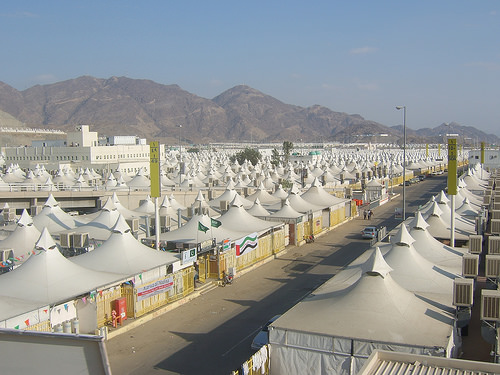
White tents as far as the eye can see.
The first thing you notice upon arriving is the massive size of the place. The Prophet, peace and blessings be upon him, stayed in this area during his Hajj, and since then, staying arrangements have been made throughout the ages that have nearly filled up the entire area with tents to fit 2 to 3 million people. Your Hajj group makes arrangements for your stay in one of them.
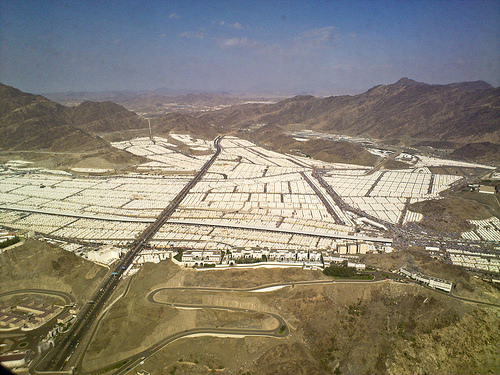
Ginormous!

Signs designating the boundaries.
There’re so many tents, Mina is better known as Tent City. Meaning you literally enter a city of tents probably the size of the Loop in downtown Chicago, all filled with tents and walkways in between. This makes it really easy to get lost if you’re not careful. The tents all look the same and are set up in patterns throughout the different sections.
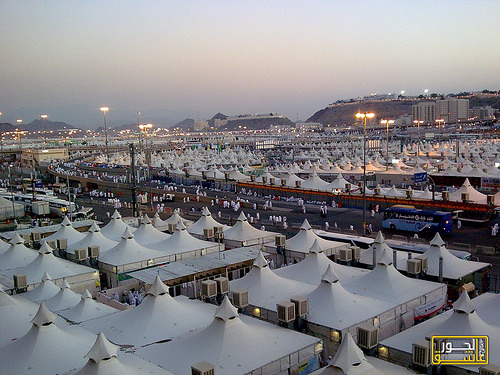
Imagine getting lost here. Some people do.

A map of the entire area. Which isn't very easy to read, btw.
Each area is split up by continent, and then by country, for the most part. You’ll see flags along walkways and bridges that overlook the tents that will give you an idea of where people are coming from.

Each flag is a sign of how far Islam has spread.
Meals for our group were given in our tents. They were small hot trays of food, each meal being lightly cooked rice and some kind of meat.
Here’s what one of the tents looks like inside. This is a standard and very typical arrangement for a pilgrim.
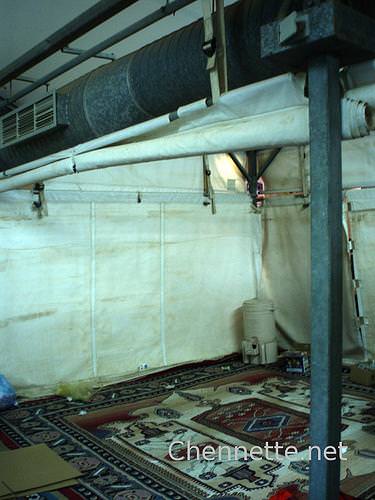
Air conditioning up top. Screens can be dropped down to separate for women.
Hajj groups give out sleeping bags and sometimes tents will have mattresses and pillows.
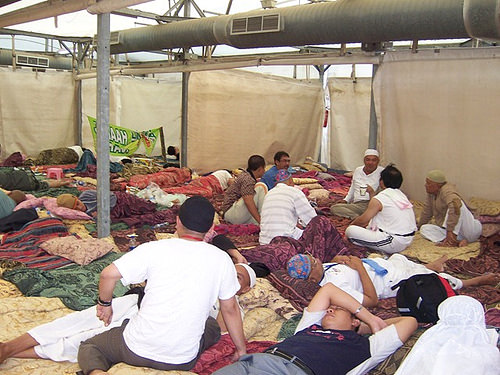
Like a massive four night spiritual sleepover.
While staying here, you begin your process of change. You’re sleeping with people who are all on the same boat as you, there to perform Hajj and be forgiven for your sins. You start to share your food with them, pray in the same tents together, watch each others’ bags while going to the restrooms, talk about stories and experience, and more. The experience of brotherhood is unmatched and builds your character (granted that you choose to let it do so).
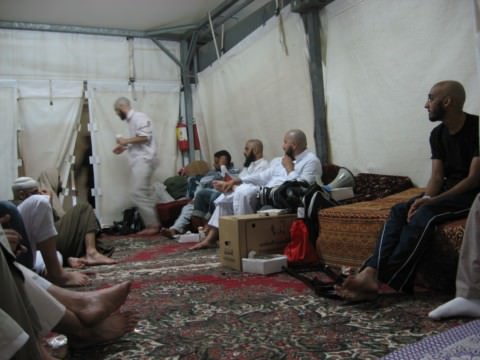
A pic from inside my tent. Good times...
Also, specifically for us Muslims coming from Western lands, we get to exorcise a lot of our comfortable demons while staying in Mina during Hajj. The bathrooms at Mina are horrendous for most people. The food, unless you pay over $10,000 for your package per person, is nothing special and gets repetitive. You learn the value of water without being close to easily accessible taps or bottled water. You recall how much of a luxury cars and public transportation are when you walk for miles all day from Mina to other places.
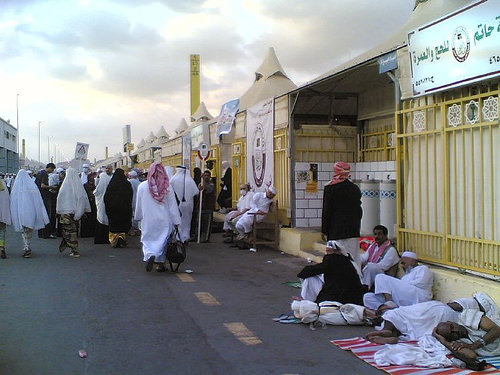
Not everyone gets to stay in tents. Some sleep outside, even if it rains.
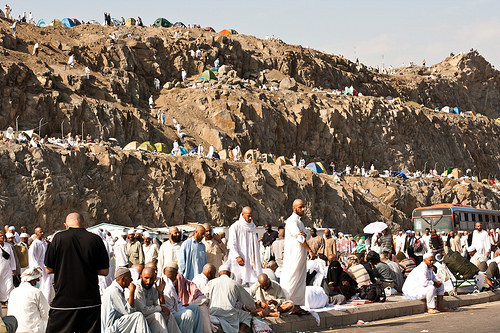
Others stay on top of the mountains!

The dreaded Mina bathrooms!
All in all, the experience in Mina builds you up perfectly while you perform the upcoming rituals of Hajj, acting as a home away from home during that time with sweet memories you carry with your forever.
‘Arafah
On the 9th of Dhul Hijjah, the Hujjaj pack up from Mina, and head out to the plain of ‘Arafah. The Prophet sallalahu alayhi wasalaam has said, “Hajj is ‘Arafah.” It is the most important day of the five days of Hajj. In fact, unlike the other manāsik (rituals) that are part of Hajj, if a Hajji misses going to ‘Arafah, there is no penalty or fee that can be paid; instead the entire Hajj is nullified!
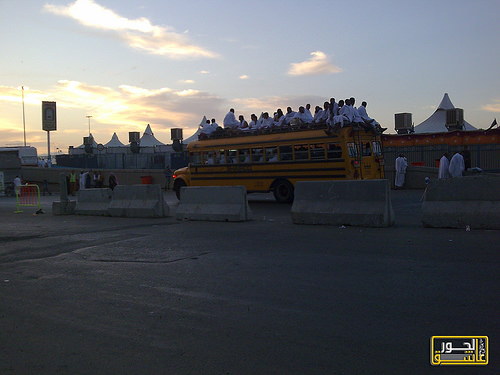
On the way to ‘Arafah, the heart of Hajj!
What you may have seen in the past is pictures of people standing on a mountain making du‘ā’. This mountain is called Jabl Rahmah.
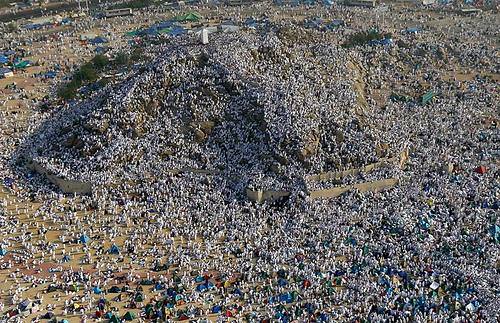
The famous Mt. Rahmah with the white pillar on top.
While many pilgrims find the strength to climb the mountain and make du‘ā’, the vast majority do not. There is no requirement to be on the mountain, so many people sit under tents, or find secluded places to make du‘ā’ quietly without any distraction. The only requirement for ‘Arafah is that you are within its limits.
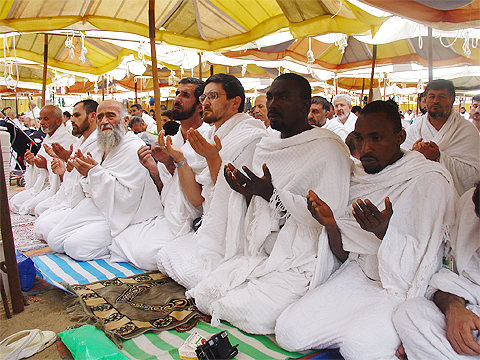
Tents are also filled with people making du‘ā'.
The time to be at ‘Arafah starts around midday. There is a khutba delivered in Masjid Namira. Not every pilgrim can attend because of the trip from Mina to ‘Arafah, so instead they listen via radio or have a khutba in their own group. After it finishes, pilgrims pray both Dhuhr and Asr combined. This is a rukhsa, or gift, given from Allah so that each Hajji is free of any obligatory prayer for the rest of the daylight hours.
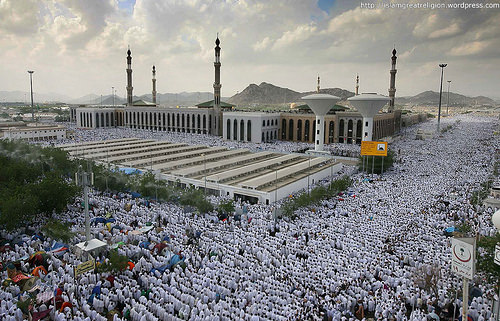
Masjid Namirah, where the khutba for the Day of ‘Arafah.
From then on, the entire afternoon is spent making du‘ā’ to Allah. All the Hujjaj are gathered on a plain in front of Allah dusty and dirty, begging for His Mercy. It’s a parable for the Day of Judgment, except this time, the pilgrims have come voluntarily. And this time they have the opportunity to change their ways, and fix themselves before they are all called before Allah once more.
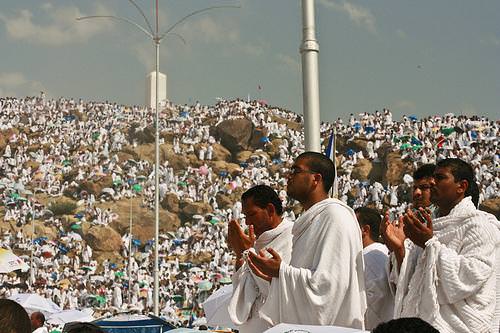
Millions of people asking Allah for forgivness. Everywhere.
It is an amazing sight to see millions of Muslims gathered together all making du‘ā’ to Allah. It is truly something that will boost your īmān and make you realize the Glory and Might of Allah. It is Allah who is Al-Mujīb and Al-Qarīb. He answers and He is close. There is no discrimination because is the Just; all those who make du‘ā’ to Allah are treated equal. The people gathered there come from all walks of life, with different problems, different requests, different dilemmas, hopes and dreams. It doesn’t matter if they are American, European, African, or Asian; Allah answers all their du‘ā’ and is close to all of them.

The most emotionally spiritual day of your life.
The afternoon is filled with strong emotions. Hearts are on a roller coaster, coming up out of fearful lows and soaring to hopeful highs. There is assurance from the Prophet, peace and blessings be upon him, that the du‘ā’ made on the day of ‘Arafah are the best du‘ā’, and that no du‘ā’ made on this day goes unanswered. So make sure, for your future Hajj trip, that you make an extensive du‘ā’ list and are prepared to ask for any and everything your heart desires.

The saddest part of Hajj: the end of the Day of ‘Arafah.
As the daylight dims, it is time for Maghrib prayer, but there is no sunset prayer in ‘Arafah. Everyone wipes their eyes, grins from ear to ear, and leaves ‘Arafah knowing anything they asked for is theirs, inshaAllah.
Muzdalifah
From ‘Arafah the Hujjaj once again pack into buses and move forward to Muzdalifah. Once they arrive they pray both Maghrib and Isha together.

Combining Maghrib and Isha at Muzdlifah before finding a place to sleep.
The rest of the night is meant for sleeping. On the morning of the 10th of Dhul Hijjah, everyone prays Fajr at Muzdalifah and moves back to Mina.
The night in Muzdalifah is probably the best night’s sleep during all of Hajj. The pilgrims arrive emotionally, physically, spiritually and mentally exhausted. They are met with absolutely no accommodations; no tent, no mattress, no water, no food.
But despite all of that, there is comfort and contentment as they lay down on the ground. Above them are dazzling stars in the deep night sky. Around them are tall, protective, strong mountains. Their companions are relaxed and spirits are high. As they all fall asleep, laughter, smiles, and relief fill the air knowing that the time in Arafah has passed and was, insha’Allah, accepted.
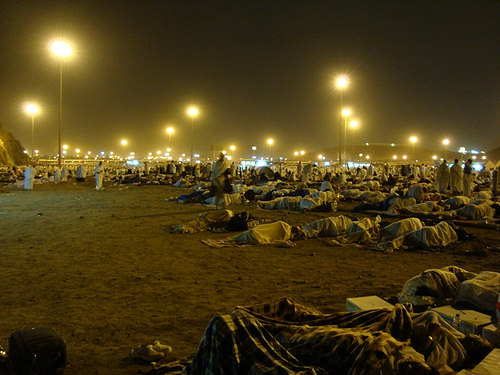
This picture doesn't do justice. There are millions of people on a flat plain all sleeping on the floor out in the middle of a plain. Simply amazing.
In the middle of the night, if you were to wake up and look around you, all you will see is death—the Hujjaj sleeping. Millions of bodies wrapped in white cloth, laying lifeless on the ground, only to wake up in the morning for Fajr. It is a time for rebirth and second chances. And so it is on the 10th of Dhul Hijjah that the Hujjaj shave their heads and make a sacrifice, just as they did as a baby when they are born into this world.

A new life, inshaAllah.
Jamarat
After you finish up going to ‘Arafah on the 9th of Dhul Hijjah and staying the night of the 10th in Muzdalifah, you still have three to four days of Hajj left. It’s during these days that you head out to the Jamarat to perform ramī, the stoning of the devil.
Located within Mina itself, this is the place where you’ve seen the pictures of thousands of pilgrims crowding around a huge stone and throwing small rocks at it. Each day remaining of Hajj, you have to go to this area to throw rocks at the large stones there while spending the nights in Mina in your tents.
The routes there get mega packed as millions of pilgrims leave their tents to go perform the stoning. The sight of throngs of people all going to one place isn’t all that at first, since you travel all at the same time. But when you get to the area and look back at how many people there are, it’s unreal! Besides the fact that the system the Saudi government created superb, you will never find yourself not amazed as to how many people come for Hajj, accepting the ancient call of Prophet Ibrahim, peace be upon him.

After Dhuhr it's the most packed.

Millions and millions of people. All going to obey Allah.
And it’s Prophet Ibrahim that comes to mind with this ritual of Hajj. As he went by order of his Lord to slaughter his son Isma‘īl, peace be upon him, Shaitan came and whispered to him in three different spots to stop him from obeying the command of Allah.

Rocks to throw at the Jamarat. Usually collected at Muzdalifah.
He threw stones at Shaitan at each of these three instances, and Shaitan was expelled away. It’s that same stoning that we perform today in Hajj at the Jamarat, with three different stones: ṣaghīr, waṣaṭ, and ‘aqabah, or small, medium and large.

Signs leading to the three stones are placed overhead.
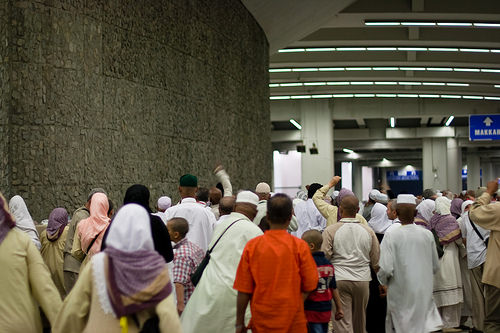
Pilgrims stoning the Jamarat.
The Saudi government has built up a massive 5 level stoning facility to facilitate the flow of the millions of pilgrims. It’s huge. A giant… thing. Looks like a massive parking lot the size of a football field. In it, there are three huge stones that go up throughout each level of the facility to allow people to stone from whichever one they’re on.
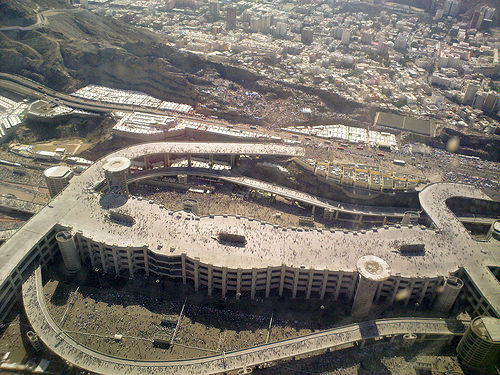
Sick aerial view provided by AlJazeera.
Naturally, the first floor is more packed, because it’s the ground level and people want to throw from the level by which not only Prophet Ibrahim threw, but also Prophet Muhammad, may peace and blessings be upon him. The top floors are much easier to throw on, with escalators leading to them to facilitate elders and families.

Escalators leading all the way up.
Many thoughts come to mind with this ritual. First, is that of death. Every once in a while you hear about people dying at Hajj or stampedes that occur. This could probably be at Jamarat, because millions of people leave throughout the day to perform their stoning, with some times being more crowded than others.
“The Jamarat are upgraded, but the roads to them aren’t,” my group leader Shaykh Muhammad Alshareef said. “That’s where you find most deaths and stampedes.”
So whether you hear about deaths that occur then, or even in your planning to go perform stoning at a less intense time such as after ‘Aṣr, you are reminded of death.
Secondly, you are performing an ancient act of incredible obedience to Allah that goes back all the way to Prophet Ibrahim. Not only are you performing a pillar of Hajj, but you’re also symbolically stoning Shaitan the same way Prophet Ibrahim did. Your whole life he has whispered evil inspirations to you, influencing a life of sin and disobedience to Allah.
Now, after a day of asking for forgiveness in ‘Arafah and being reborn in Muzdalifah, you throw seven pebbles at each symbolic stone representing him in a way of riding his past influences on you even further.

An emotional ritual of spiritual cleansing.
Even if you don’t feel a connection in the symbolic connection to Prophet Ibrahim’s act because you’re throwing rocks at a huge stone made by the Saudi government in an air conditioned facility, as Imām Al-Ghazālī said in Iḥyā’ ‘Ulūm Al-Dīn, you’re still “throwing them in the face of the Shaiṭān and you are breaking his back with them, because nothing annoys him except your obeying the command of Allah out of veneration for Him, simply because of His command, and the soul and mind have nothing to do with it.”
Conclusion
Now that you have a brief glimpse of the major bits of Hajj, you can understand them a bit better when you hear people talking about them and as you prepare to make your own Hajj inshaAllah. For those of you who’ve gone, which of these events and places did you love the most, and what was your experience like there and then?
Keep supporting MuslimMatters for the sake of Allah
Alhamdulillah, we're at over 850 supporters. Help us get to 900 supporters this month. All it takes is a small gift from a reader like you to keep us going, for just $2 / month.
The Prophet (SAW) has taught us the best of deeds are those that done consistently, even if they are small. Click here to support MuslimMatters with a monthly donation of $2 per month. Set it and collect blessings from Allah (swt) for the khayr you're supporting without thinking about it.
SaqibSaab is an average Desi Muslim guy living in Chicago. He enjoys videography and design as side hobbies, and helps out with AlMaghrib Institute in Chicago, Wasat Studios, and other projects here and there. His go-around vehicle is a 2007 Volkswagen Jetta 5-speed Wolfburg Edition. Originally born in Michigan, he and his wife reside in Chicagoland with his parents who come from Bangalore, India. He blogs personally at SaqibSaab.com.


Nationalism And Its Kurdish Discontents [Part I of II]: Kurds In An Ottoman Dusk

Moonshot [Part 10] – The Marco Polo

Moonshot [Part 9] – A Religion For Real Life

Genocidal Israel Escalates With Assault On Iran

Relief Convoys To Gaza Expose Discrepancy Between Society And State

Moonshot [Part 9] – A Religion For Real Life

Moonshot [Part 10] – The Marco Polo

Moonshot [Part 8] – The Namer’s House

Moonshot [Part 7] – The Abyss Stares Back

Moonshot [Part 6] – Down These Mean Streets

[Dhul Hijjah Series] Calling Upon the Divine: The Art of Du’a (Part 1)

IOK Ramadan 2025: Four Steps | Sh Zaid Khan

IOK Ramadan 2025: Do Your Best | Sh Zaid Khan

IOK Ramadan 2025: Giving Preference to Others | Sh Zaid Khan








Amad
December 31, 2009 at 5:53 AM
Dude, I feel like I am there… this series has been incredible mashallah!
One slight issue… you don’t really nail the shaitan :) Stoning is symbolic and I am not even sure if it is symbolic of the story mentioned… not sure, can’t remember for some reason. The problem with people feeling that it’s shaytan they are hitting, gets them riled up and some want to throw chappals, fellow hajjis, etc… the bigger the better. So, this misunderstanding leads to a mountain of chappals at the bottom of the jamarat!
More clarification needed…
huddi
December 31, 2009 at 10:31 PM
im sure it hurts him either way, but i know what you mean. getting riled up and going crazy, throwing slippers and stuff is probably more pleasing to him than displeasing.
Huddi
January 2, 2010 at 11:41 PM
i meant like, im sure he hates it, and it hurts him internaly, as does any act of worship, but maybe this one even more? wallahu a’lam.
ayesha
January 1, 2010 at 1:34 AM
from http://www.islamqa.com/en/ref/34420/jamarat
Mistakes that are made when stoning the Jamaraat
Some people think that these Jamaraat are devils,and that they are actually stoning devils, so you may see them becoming very emotional and very angry, as if the Shaytaan himself is in front of him, and this leads to the following grave errors:
1-This is a mistaken notion.We stone these Jamaraat as an act of remembering Allaah, following the Messenger of Allaah (peace and blessings of Allaah be upon him), as an act of worship. If a person does an act of worship and does not know its benefits, but he does it only as an act of worship for Allaah, this will be more indicative of his humility and submission to Allaah.
2- A person may become very angry and emotional, so you see him disturbing people greatly, as if the people in front of him are vermin and he doesn’t care about them or the weak among them, he just goes forward like a crazy camel.
3- A person may not remember that he is worshipping Allaah by stoning these Jamaraat. Hence he neglects to say the dhikr prescribed in sharee’ah and says words that are not prescribed in sharee’ah, such as saying, “O Allaah, we are angry with the Shaytaan and are pleased with al-Rahmaan (the Most Merciful),†even though this is not prescribed when stoning the Jamaraat; rather what is prescribed is to say “Allaahu akbar,†as the Prophet (peace and blessings of Allaah be upon him) used to do.
4- Based on this false belief you will see some people picking up large rocks and throwing them, because they think that the bigger the rock, the greater the effect and revenge on the Shaytaan. You also see them throwing shoes, pieces of wood and the like, which are not prescribed for throwing.
So if we say that this belief is false, what do we then believe about stoning the Jamaraat? We believe that we stone the Jamaraat as an act of veneration and worship of Allaah, and following the Sunnah of the Messenger of Allaah (peace and blessings of Allaah be upon him).
sister
December 31, 2009 at 7:19 AM
Assalamualykum brother,
Subahanallah..Incredible pictures.Mashaallah..Jazakallahu khairaa..Never went for hajj and so this series helped me a lot what to expect.May Allahtaala accept all your duas.
salaam.
Afiya
December 31, 2009 at 2:20 PM
Subhanallah, awesomeee article…
It totally takes you back there, and makes you relive your hajj experience
I remember every single moment so vividly…
Arriving at Mina…the Lightening, rain dripping down into our tents… the indescribable sense of akhuwa that develops with the people in your tent….
“Also, specifically for us Muslims coming from Western lands, we get to exorcise a lot of our comfortable demons while staying in Mina during Hajj.”
Subhanallah, This brings back memories of our facial expressions when some sisters from the UK and I first saw the Mina bathrooms…
the day of Arafah… everyone on the bus chanting the talbiyah en route to the plains of Arafah….Praying inside Masjid Nimrah…. the walk back amid millions of people in the sweltering heat, the rest of the day spent making duaa
Subhanallah this day is probably the single most emotional, and spiritual day in the life of a Muslim,
a feeling of closeness with your Rabb, like you’ve never experienced before
The feeling of happiness and hope for a fresh start as you arrive at Muzdalifa… and then the world’s biggest sleepover outside on the ground, under the stars =)
Jazakallah Khayr for the articles, I loved this Hajj series, it was awesome, and brought back so many memories, feelings, and reflections right after we came back from Hajj!
huddi
December 31, 2009 at 10:26 PM
ridiculous pictures mA. JK
huddi
December 31, 2009 at 10:29 PM
I got lost in Mina at night on my way back. Had to find my way to my tent with the help of guards and maps, was very interesting.
Asad
December 31, 2009 at 10:59 PM
Thanks for posting the pictures, guys! The one of our Mina tent almost made me tear up!! I miss you guys and the rest of my Hajj companions!
Ameera
January 1, 2010 at 2:30 AM
You people are bent upon making me nostalgic. :(
Seriously, these pictures have captured the gist, the essence of what the Hajj experience is like! Those who will be performing Hajj in the future, Insha’Allah, will find these scenes repeating before them. :)
ayesha
January 1, 2010 at 7:09 AM
The “dreaded” Mina bathrooms!…i dont think this caption is beffitting…the adjective used is inappropraiate….May Allah forgive us
Ameera
January 2, 2010 at 3:54 AM
Agreed. My mother described the poor condition of the washrooms back in 1989 and when I went in 2006, I was highly grateful throughout the trip just to see them there and available in working condition!! :) My mother had mentally prepared us to expect wooden shacks, without water, especially in places like Muzdalifa where you stop over only briefly. However, Alhamdolillah, we have running water and that too is luke warm! :D
SaqibSaab
January 2, 2010 at 8:37 AM
@ayesha
I see where you’re coming from and think my caption deserves some explanation.
Before going to Hajj, people give a lot of tips and advice on what to do and not to do. One of the things I heard a great deal about were the bathrooms of Mina and other places. You hear about how poor their condition is, that they’re so dirty, this and that.
Personally, I wasn’t worried at all. I’ve visited family in India multiple times both in the city and village parts of Bangalore and as an ABD (American born Desi) I came to terms with third world bathrooms a long time ago.
But for a lot of Hajjis coming from Western countries (the intended audience of this blog), they were *very* scared of the idea of bathrooms that (1) were a hole in the ground, (2) were wet and dirty, and (3) smelled bad. I’m talking very scared. Like horror movie scared. To the point where the bathrooms were the #1 thing they feared going into Hajj.
In fact, I heard a story about a sister who because of the bathrooms refused to go for three days and ended up getting a urinary tract infection as a result, making her Hajj situation even more difficult on her. It’s stories like this why I called the bathrooms “dreaded.” Because, like it or not, people actually are scared of them!
Be that as it may, no matter how scary they may be to such people, everyone *has* to use those bathrooms. You’re there for four to five days, and there are hundreds of people sharing the units of toilets within the same tent area, thousands in your area at Muzdalifah, and millions at the bathrooms of the Haramain.
What ends up happening is this: you not only end up going through it (because you have to), but, like Ameera mentioned, you walk out seeing that they’re not all that bad. Almost like a rite of passage.
Sound silly? To some, yes. But to a lot of us Westerners who are so used to pristine lifestyles, it can go a long way.
1. The experience reminds us of the bounties Allah has given us back home and like I mentioned in the post exorcises some of our luxirous lifestyle demons we come to Hajj with, even with something like the bathrooms we use.
2. Here you’re sharing bathrooms with people from all over the world, reminding you that your’e the same as anyone else and are above no one.
3. Because of the sheer amount of people there, you simply have to deal with the fact that the bathroom will probably not be clean when you’re using it.
At the end, it makes the bathrooms that were once “dreaded” not very dreaded at all.
So while you and I agree that the bathrooms weren’t really so bad, not only are there people who fear them, but everyone walks away from them with a bit of a reminder of our blessings and realize they weren’t all that bad in the first place.
I apologize if the comment came off as inappropriate and hope this explanation makes sense.
Man, I can’t believe I wrote such a long comment about bathrooms and toilets. :)
ayesha
January 2, 2010 at 11:43 AM
well in short you meant “fearful”…by dreadful…and not terrible(as it sounded) or anything of that sort!!..
jazakAllahukhairan for your response..
Habeeb
January 2, 2010 at 4:37 PM
Agree with Brother Saqib when he says:
Be that as it may, no matter how scary they may be to such people, everyone *has* to use those bathrooms.
On top of that:
Not everyone gets to stay in tents. Some sleep outside, even if it rains.
If you have been to Masjid Khaif in Mina, don’t be surprised to see pilgrims sleeping on the toilet floors, albeit with their own sajadahs etc.
shahgul
January 3, 2010 at 12:00 AM
I would be more scared of using an angrezi toilet in the mall, where you don’t know who sat before you. The hole in the ground is more hygienic as nobody touches it. Also, there is running water available. I am all for ‘Indian Toilets’ (thank God they are not called Pakistani) in public places.
Ameera
January 3, 2010 at 12:14 PM
Point well made. Long point but well made. Even I thought “dreaded” was your own opinion but I see now that it wasn’t! Alhumdolillah.
:)
After all that, might I add that the washrooms are indeed a “challenge”! :) I’m not saying this to make myself sound great or anything, but during the night-stay at Muzdalifa, I spent over an hour near the washrooms trying to get people to make queues and stop fighting at the door of the stall! Alhumdolillah, things got a lot smoother after people made lines.
Wow, so many “washroom” stories… you should do a post on this, considering how everyone seems to “dread” them!
Aly B - DiscoMaulvi
January 1, 2010 at 10:31 AM
Assalamu’Alaikum:
Jazak’Allah Khairin Saqib for the wonderful recounting of Hajj. Makes me wish I wasnt back from there already. I had planned to write a recounting of Hajj post to the blog but your series is so extensive I dont feel the need. :)
-Aly
http://discomaulvi.wordpress.com/
http://www.twitter.com/DiscoMaulvi
Holly Garza
January 1, 2010 at 3:44 PM
SubhanaAllah!!!! MashaAllah this was an amazing read and view for me. I could almost imagine what the people may have felt!
Everything was so in depth and the pictures MashaAllah!
Very good post!
ttpor
January 1, 2010 at 7:16 PM
Those flags are in most cases just a display of jahiliyya.
AM
January 2, 2010 at 6:55 AM
Assalaamu ‘alaykum
I find your comment quite strange. I do not know the intention in the heart of every person who put up those flags, but I can tell you that my group did not put up our flags as a display of jahiliyyah. It was for a simple reason – so that the hujjaj could find our tent amid the thousands of identical white tents.
As I said, I don’t know the intentions in the hearts of the hajj froup leaders, but perhaps they erected their flags for this same simple reason – to help to prevent their hujjaj from getting lost. I think that most people who have been to Mina in Hajj appreciate the function these flags serve.
amad
January 2, 2010 at 9:43 AM
its not a strange comment, its an arrogant comment that spawns from the notion that any sort of national display is jahiliya… it ignores the fact that the Prophet (S) himself loved Makkah. The nationalism that is forbidden is the type that makes you feel superior to another Muslim, and in this case, that doesn’t apply of course.
May Allah forgive us all.
Habeeb
January 2, 2010 at 4:26 PM
Assalam Aleikum,
Akhi, those flags are put up for the purpose of helping lost pilgrims find their tents. There are over 3 million pilgrims, with over hundreds of different languages and dialects. On top of that, not everyone can read and write. So just putting up signs in major languages, Arabic, english, french, urdu, etc, just ain’t going to cut it. The easiest way for people to find their tent, and for the Saudi police to help them find their tent, is to put up national flags to show which countries are being housed in this part of Mina. Once they get there, countries with huge number of pilgrims attending, e.g. India, then have their own office with their helpers that can speak several different Indian languages. They then help the pilgrims find their exact tent within the ‘Indian area’.
Please forgive me for the harsh tone, but if one has no experience in the logistics of dealing with over 3 million pilgrims from all four corners of the globe, then they should think twice before criticizing.
Habeeb
Ayesha A.
January 2, 2010 at 9:47 AM
wow …lovely picturessss..it reminds me when i had been there back 6 yrs ago…
.btw,may i know what megapixel cam is that:)))))
Ayesha A.
January 2, 2010 at 9:52 AM
wow lovely pictures…the quality of ur pictures is greatttt…
shahgul
January 3, 2010 at 12:04 AM
I never thought of the Hajj as a major camping trip. Most of the time, you only see pictures of people circling the Kaaba. I hope to go to Hajj next year. Say Ameen!
Tanveer
January 4, 2010 at 9:52 AM
SaqibSaab,
I just need to hug you buddy, first because your a Hajji now, second you reminded me about every moment of my Hajj last year.
It is not the pictures that matters to me, as they are already ingrained in my heart, but what you said in these lines touched me…I want to feel the moment again
What if everyone who went to Hajj thought like you did, every year we would have 4 – 5 million powerful practicing Muslims, great daee’s to spread the message…May Allah open everyone’s heart to see and reflect what Hajj really means, Ameen
Me and Nasir accidentally woke up in Muzdalifah and were trying to use empty bathrooms, we were amazed seeing all men lying down or sitting in white and were thinking of what if this was a war zone and all are dead (think of seerah the battles sahabaas have fought), it was nerving, tears without reasons were rolling down….SubhanAllah, our deen has everything in it for us to enjoy for this world and hereafter, but we are just hooked to duniyaa
Jazakallah khair, your pictures are hiding your powerful words…
Saqib, reply to my email about Jan Khutbah…now
Salaam,
Tanveer
onez
January 7, 2010 at 7:53 AM
amazing pics. brought back memories of our Hajj last year. its a journey of a lifetime.
afreen
August 28, 2010 at 12:07 PM
Mashallah!!! U seem to be a wonderful writer,who knows how 2 put all the experiences and emotions into words.Not every one can do that.Inshallah am goin 4 hajj wt my hubby ths yr.Ur article made me cry so much that i finally had 2 ask myself “why am i crying so uncontrollablÿ?” I think it is the emotion of having been able 2 make the niyyah for the most incredible journey of a muslim’s lifetime,plus the pictures that gave me a much awaited glimpse of it all nd the beautiful way u’ve wt putting it in2 words.Mashallah and subhanallah.
Your words were very powerful here when u said : “It is an amazing sight to see millions of Muslims gathered together all making du‘Ä’ to Allah. It is truly something that will boost your Ä«mÄn and make you realize the Glory and Might of Allah. It is Allah who is Al-MujÄ«b and Al-QarÄ«b. He answers and He is close. There is no discrimination because is the Just; all those who make du‘Ä’ to Allah are treated equal. The people gathered there come from all walks of life, with different problems, different requests, different dilemmas, hopes and dreams. It doesn’t matter if they are American, European, African, or Asian; Allah answers all their du‘Ä’ and is close to all of them.” Its so true…subhanallah…
“As the daylight dims, it is time for Maghrib prayer, but there is no sunset prayer in ‘Arafah. Everyone wipes their eyes, grins from ear to ear, and leaves ‘Arafah knowing anything they asked for is theirs, inshaAllah.” Beautifully stated.These words inspired me to be extra cautious as not 2 miss the chance of a ifetime i have to ask for anything thts halaal to my one nd only Lord all of which he’ll never trun down…
Jazakallah Khairan
Ur sister in Islam
Pingback: Recounting Hajj pt. 5 – How We Almost Missed ‘Arafah Day | MuslimMatters.org
Pingback: SaqibSaab » Recounting Hajj pt. 5 – How We Almost Missed ‘Arafah Day
Pingback: Recounting Hajj pt. 5 – How We Almost Missed ‘Arafah Day
amatullaha
November 24, 2010 at 3:38 PM
Salaamu’alaykum warahmatullah.. just returned from Hajj 2010 – looking through these pictures – subhaanAllah. Jazaakumallahu khayr.. just a question… why have you not included tawaaf al ifaada and tawaf al wida??
Tasleem Hussain
December 6, 2010 at 6:17 PM
Alhamdulillah performed my hajj this year. by the grace of Allah swt. Hey no matter what the washrooms were like or whether you encountered whatever hardship or difficulty…….does it really matter ? YOUR LORD INVITED YOU! ARE YOU GOING TO BE AN ANNOYING, COMPLAINING GUEST, or are you going to say labbaik……….. indeed my Lord I am here, I shall be a worthy guest and be happy with whatever You wish to test me with! Is it more important that I please You or are the ‘washrooms’ at the top of my priority list?
Pingback: Hajj Chronicles Part 26: Day 3 – Euphoria « slip-sliding away…..
Pingback: Hajj Chronicles Part 28: Boom! « slip-sliding away…..